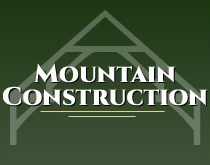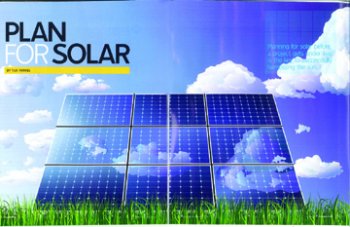For more information on building or a free consultation CONTACT US
Plan for Solar: Planning for solar before a project gets under way is the key to successfully harnessing the sun.
By Tux Turkel
Reprinted from Green Builder Magazine, October 2010 greenbuildermag.com
After 30 years of living in a home that was hot in summer and cold in winter, Margie and Jim Lussier recently moved to a new house that's very energy efficient and comfortable. What's not obvious from the street is that the house soaks up solar energy three ways: through large, south-facing windows, and with discrete, rooftop panels, once set that heats water, the other that converts sunlight to electricity.
Constructed to top level Platinum LEED standards, the Lussier's custom home is crammed with green building features. But it doesn't scream solar. The panels and passive solar features are carefully integrated into the $500,000 home, which fits nicely into an existing subdivision in Bend, Ore.
"You can barely see the panels when you're on the ground," says Margie Lussier. "They disappear into the roof. We wanted to show you can have a house that doesn't look like it's solar, but it is."
Buyers of high-end homes increasingly are asking for solar energy as part of the custom-home package. Government incentives, particularly those in states such as Oregon, make the panels and related gear needed for active solar applications more affordable than ever.
But doing solar right isn't a matter of just hanging panels on a handsome house. From the start, the building must be air-sealed and insulated well enough to use very little heat and air conditioning. It must have efficient lighting, appliances, and mechanical systems that reduce the demand for hot water and electricity. And it should be oriented correctly to the sun.
"Make sure you're integrating all aspects of energy conservation into the home before you integrate solar on the roof," says Cindi O'Neil, vice president of sales and marketing at SolAire Homebuilders in Bend, Ore., the company that built the Lussier house. "Then it's the right kind of icing on the cake."
O'Neil has a good vantage point from which to view the evolution. SolAire offers building options with three levels of energy efficiency, including a top-level package with both solar hot water and electric. Roughly nine out of 10 customers end up with solar panels, she says, and it's rare for a home costing more than $400,000 not to have at least solar hot water.
"We fill out all the [tax rebate] paperwork for customers and make it easy," O'Neil says. "We make it like any other option, like adding a sink."
Hot water is the first choice, because it can slice water heating costs by 80% in sunny, central Oregon. A system that retails for $8,500 can net out at $3,390 after state and federal incentives.
Solar electric, or photovoltaic panels, also can make economic sense these days, thanks to incentives. A typical 2kW system, like the one at the Lussier's house, will trim power costs by only a quarter. But a mix of tax rebates and utility-sponsored programs currently cut the $17,500 retail price by a whopping 90%, O'Neil said. And a new feed-in tariff--essentially a premium that utilities must create a positive cash flow from the system over time.
To make solar work at the Lussier's four-bedroom, 2,400 square foot home, SolAire Homes started with the building shell. The walls are insulated to an R-30 value. The ceiling is R-49, and the slab is R-15. Seams and penetrations are sealed with foam or caulk. Windows are high-efficiency. A whole-house energy recovery ventilator and filtration system keeps indoor air clean.
All appliances are Energy Star qualified. CFL and LED lights make up 80% of the lighting system. Toilets, faucets, and washers are water-stingy. Drought-resistant landscaping, and a system that captures and stores rain from the roof saves water in the high-desert environment. These features add up to savings: The Lussiers spent roughly $1,000 on their total energy bills in the first year.
The home's southern exposure helps, but not every home site has optimal orientation. And sometimes, there's a competing interest. Scenery won over sunshine in a nearby subdivision, where SolAire recently built a stunning $1.1 million home next to a golf course. Views of the course and Cascade Mountains led the owners to design a home with huge expanses of west-facing glass. But high insulation levels, a geothermal heat pump, and solar panels installed on a side roof combine to give the home Platinum-level LEED certification.
The home's out-of-sight solar panels underscore an important consideration. Some homeowners are proud of their solar decisions and are happy to have highly visible panels. Others opt for more-subtle solar. Some homeowner associations and architectural review committees have rules covering panels, such as installing them flush to the roof. State solar access laws and local zoning ordinances also vary, so builders and homeowners need to stay up to date. Arizona, for example, has a strong solar access law.
"The homeowner associations realize their power is limited in stopping people from using solar," says Mike Meixner, purchasing manager at Dorn Homes in Green Valley, Arizona, near Tucson.
Dorn Homes has expanded its green building philosophy by offering a Solar Smart option. It includes a 2.8 kW solar electric system and hot water panels. The homes are designed to be between 50% and 75% more efficient than houses built to standard codes. Again, it's not the solar panels that make the biggest difference, it's the building envelope and attention to detail. Features include:
-Heavy insulation and air sealing. Argon gas-filled windows.
-Sealed ductwork located inside the insulated part of the home.
-Programmable thermostats
-Energy-efficient ceiling fans and appliances.
-Water conserving toilets and plumbing.
Coupled with existing federal tax credits, Arizona's renewable energy incentives go a long way to making solar attractive for buyers, Meixner says. High-end home buyers generally want to incorporate renewable energy into their projects, he says, but government and utility incentives are critical, he says. In his market, they give customers roughly a 20% return on their investment.
For some custom home owners, though, solar is more than just part of the package--it's the focus. That's fine, from an energy standpoint. But the ongoing saga of a super-solar mansion in Newport Beach, Calif., serves as a cautionary tale. It's an extreme example, to be sure, but a reminder about the importance of aesthetics in high-end neighborhoods.
Steve and Mashid Rizzone recently moved into a 9,000 square foot luxury home that is designed to generate all the electricity it needs. To do it, Premier Power Renewable Energy of El Dorado Hills, Calif., installed 168 Sharp solar panels on a south-facing hillside beneath the home. The array measures 50' by 60' and has the capacity to generate 36kW.
"We had a hillside with an ideal solar angle, and I wanted to take advantage of it," Rizzone says.
Rizzone, Tony Valentine Construction of Corona del Mar, Calif., and the architect, Marcelo Lische of Laguna Beach, Calif., worked on the project for five years. The home is rated LEED Platinum. Rizzone says he wanted it to be one of the greenest custom homes in the United States.
While it's hard to downplay the contribution of solar, building envelope and energy management systems also play important roles in making the house super green. For instance: Steel framing is covered with an exterior insulation system. An Apple-based Savant home automation control system manages lighting and air conditioning. Those demands are low, thanks to a nine-zone HVAC system and LED lights. The controls also move shades across windows, based on the time of day and movement of the sun.
But not everyone is enthusiastic about 3,000 square feet of glass and metal covering a very visible hillside in a community of multi-million homes. Local media have interviewed several neighbors who call the array an eyesore.
California's tough solar access law prevents projects from being stopped, based on aesthetics. And Rizzone is planting trees and shrubs to soften the impact. Rizzone says it will take time for people to understand and appreciate the nation's dire need for alternative energy sources.
"We aren't trying to send a message," he says. "It's just what we believe in."
That may be true, but the take-home message for custom builders and designers is to make solar energy fit in with their projects, and not the other way around.
Mountain Construction is a full service custom builder offering Log, Timber Frame, Structural Insulated Panels nationally as well as local New Construction of any type and Remodeling and Restoration services. We are NAHB Certified Green Professionals.
To find out how we can help you build or remodel your home CONTACT US.


